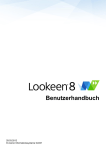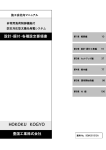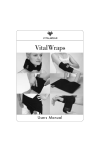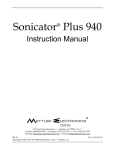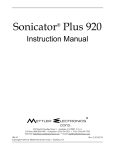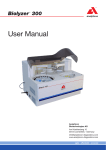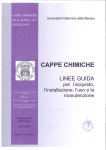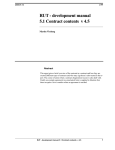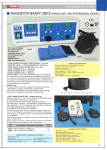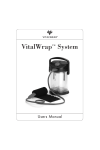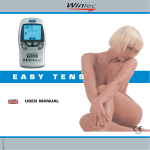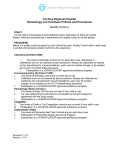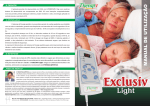Download USER`S MANUAL - Amazon Web Services
Transcript
Sigma USER'S MANUAL Rev. i EASYTECH s.r.l. Via della Fangosa, 32- 50032 Borgo San Lorenzo (FI) Italy tel. 055 8455216 - fax 055 8454349 e-mail: [email protected] Direct Technical Support number: 348 2316323 0434 This device is compliant with Directive 93/42/EEC applicable to medical devices. Its compliance has been verified in accordance with the requirements of standard CEI EN 60601 No part of this publication can be reproduced, transmitted, copied, recorded or translated in any language, form or electronic, magnetic, optical, chemical, manual, physical or any whatsoever means, without the written authorization of EASYTECH s.r.l., Via della Fangosa, 32, 50032 Borgo San Lorenzo (FI) , Tel. 055-8455216, Fax 055- 8454349. EASYTECH s.r.l. reserves the right to review and change the content of this document without prior notice. Release: 08/7/2010 Title – Sigma User's Manual Internally reviewed by MUSsigma - GB - Rev. i 5 GUIDELINES WARNING. Before proceeding, make sure that the safety instructions (Chapter 2) are complied with, and that there are no contraindications for the patient (paragraph 2.6). It is obviously essential to be familiar with the content of the manual. 5.1 SmarTherapy, Sigma and the medical device used for the treatment SmarTherapy is originally based on the solid foundations of DeltaHyperthermia but is designed to amplify in some pathologies the results of hyperthermia and extend the field of application to areas that can normally not be treated with hyperthermia (for example in acute phases). However, over time it has become a new form of therapy mainly because of the synergy resulting from the combination of DeltaHyperthermia and Controlled Transdermic Cryothermia. The term synergy is specifically used in this context to highlight the fact that the effect goes far beyond the advantages resulting from the combination of individual effects. Some of these effects are not directly related to the operator, like standard DeltaHypethermia, while others require the continuous presence and interaction of the therapist during each session. This adds greater flexibility to SmarTherapy, because it enables operators to select for each pathology both the optimum mode, but also an alternative mode that still guarantees good performances. In other words, therapists can choose the operating mode according to whether they desire a greater flexibility or prefer to supervise the patient more closely in consideration of the fact that the anxiety of the patient could affect the results of the physical rehabilitation. SIGMA is the only device that is currently able to offer all the therapeutic modes that are normally part of SmarTherapy. SIGMA enables to carry out a wide range of "thermal cycles" on the muscular-skeletal tissues, all of which are characterized by a high degree of accuracy both in terms of temperature control and of location of the induced phenomenon. This device enables to apply all types of local hot and cold treatments, and specifically those that are typical of SmarTherapy and that leverage the synergy between Hyperthermia and Cryothermia. The methods used to add or subtract heat to/from the tissues enables to fully exploit the effects of the temperature variations induced locally in specific areas of the muscular-skeletal system. Temperature accuracy and localization are essential requirements to achieve a physiological reaction of the desired type and intensity, but are also specifically used to avoid exposing healthy tissues to the treatment. To prevent unnecessary exposure, it is obviously important for the therapist performing the treatment to have an appropriate diagnosis and be able to accurately identify the point where the treatment has to be applied. In the event of the slightest doubt or if the volume to be treated is particularly extended, it is possible to move the application point by 1÷2 cm from session to session. SIGMA uses a combination of two techniques: DeltaHyperthermia to heat the tissues and Controlled Transdermic CryoThermia to cool them. Both treatments are performed using different applicators. For each therapeutic mode, it is obviously necessary to set a specific number of parameters. This operation can be practically and easily carried out by means of the menus that can be managed through the keyboard. There are 11 modes available, each with one or more options specifically designed to allow operators to perform a targeted treatment. The selected mode is shown on the display by means of a number on the left and the acronym in the center, while the number on the right represents the actual selected option. The mode substantially defines the type of thermal therapy, while the option enables to adapt the therapy to the structure, thickness and type of treated tissues and to the desired intensity. The table that follows provides an overview of the applications for which SIGMA is currently used. The numbers in the left boxes correspond to the related descriptive paragraphs. There are obviously also traditional treatments that foresee the application of heat only (DeltaHyperthermia) or cold only (Controlled Transdermic CryoThermia). Structure, thickness and types of tissues are generally identified by means of a few general terms, depending on the diagnosis, help the therapist to select the most appropriate options. Tissues are classified as "interposed", meaning that the tissue is located between the applicator and part to treat, and "target", which identifies the part to be treated, but also simply as "muscular" and "non muscular" (or articular). A tissue is considered muscular when at least 40% of it is considered muscular and classified as non muscular in all other cases. Skin tissue, which is characterized by a high perfusion, should never be taken into account, because is has already incorporated in the device parameters due to the fact that it is always present and generally consistent. Paragraph 5.2 explains in detail how to scroll the menus and manage a session using the control buttons, while paragraph 5.3 provides suggestions on how to manually correct the Tw and DeltaT parameters of some modes while a session is in progress in order to achieve a standard level, but also levels with a slightly higher or lower intensity, and be consequently able to adapt the therapy to all possible situations. The selection of the appropriate mode enables to reduce the pain resulting from muscular-skeletal pathologies, degenerative dysfunctions, overloads and post-traumatic acute, post-acute and/or chronic conditions affecting deep and clearly localized structures. This type of application is particularly effective when used to treat all types of muscular and tendon pathologies caused by sports traumas. Sigma is therefore always particularly effective to treat the following pathologies: Traumas (specifically caused by sports activities: contractures, stretches, elongations, muscular lesions, hematomas, distortions, etc.) Post-traumatology (rigidity, pain, edemas and muscular hematomas that risk becoming chronic, deep inflammations that are slow to heal, etc.) Overload syndromes (specifically in athletes: tendonitis, tendonitis, etc.) Compression syndromes (carpal/tarsal tunnel) Degenerative arthropaties in all possible locations Rachialgias (cervical and lumbar algias, lumbar sciatica, etc.) Fibromyalgias and myalgias The therapist should always carefully evaluate the recovery stage of the patient's tissue before starting the treatment. The procedure for the application of heat and cold during the rehabilitation of traumas may significantly vary depending on whether more or less than 48÷72 hours have elapsed from the event. In the initial phase, the treatment mainly consists in applying cold or at any rate in carefully applying a moderate amount of heat. In the second stage, the prevalent treatment used is hyperthermia, because cold is mainly used to amplify and stabilize the effect. If a muscular trauma with a micro-circulation injury is treated within 48÷72 hours from the event), it is necessary to minimize the transfer of blood and thus achieve a specific level of vasoconstriction (cold), while in the subsequent sub-acute phase, when circulation has been mostly restored, applying cold slows down healing, whereas hyperthermia (even if precocious and moderate) helps to increase the reconstruction rate, even in the deeper layers. It is important to remember that all the treatments applied even a few hours after sessions that cause vasomotorial reactions, as occurs in some of the treatments described below, must necessarily be more moderate. A "strong manual massage in depth" may actually worsen the situation and cause bleeding, because two "therapeutic insults" (that is a thermal and mechanical action) are not easily tolerated by a tissue that it still healing. In other words, an approach of this kind results in an excessive therapeutic treatment. It is important to remember that SmarTherapy is not a semi-placebo that can be applied without limitations. In some treatments the transition from cold to hot is particularly sudden and intense. If the patient is particularly sensitive and reactive, and thus unable to tolerate these transitions, it is possible to "smoothen" this contrast by temporarily suspending hyperthermia (that is reducing radio frequency to zero). By doing so, the area is basically heated by the bolus only and restarting the treatment after a while, generally after 1-3 minutes, eliminates the problems described above. HYPERTHERMIA DH, DeltaHyperthermia 01 SDH, Standard DeltaHyperthermia. Traditional hyperthermia with typical consolidated properties. 02 DHH, Dynamic Heat DeltaHyperthermia. Dynamic deltathermia with heat variation. "Thermal massage": several hyperthermia heating cycles followed by a pause stimulate the opening and closing of the smaller vessels, optimizing revascularization. 03 DDH, Dynamic Depth DeltaHyperthermia. Dynamic DeltaThermia with variation of depths. Enhances the therapeutic depth and is particularly effective if the injury affects the deeper layers. 04 STU, Local Systemic Drug Enhanced TakeUp. Enhances the absorption of drugs and increases perfusion. YET TO BE VALIDATED. 05 WDH, Wet DeltaHyperthermia. DeltaThermia with superficial wet heat. YET TO BE VALIDATED. CRYOTHERMIA CT, CryoThermia 11 CTC, Controlled Transdermic Cryothermia. Application of exogenous cold by means of a cold applicator. Recommended for all suitable applications and also for "Spray and stretch" techniques. CRYO-HYPERTHERMIA, CDH, CryoDeltaHyperThermia 21 STS, Superficial Dynamic Thermal Shock. "Thermal-Cryokinetics". Balancing of the action depth of cold and heat: significant thermal variations in both directions down to an average depth. Stimulates the reparation of: micro-circulation, connective tissues, tendons and generally all limb tissues. Antalgic effect. 22 TS, Deep Direct Dynamic Thermal Shock. Cold action applied in depth. Stimulates the reparation of the muscular tissue, including cicatrized areas or calcified injuries. 23 MRA, Movement Recovery Aid. Greater smoothness and slight analgesia to aid manual mobilization therapies. 24 RRA, Movement Range Recovery Aid. Temporarily reduces the rigidity of the connective tissue on which a static force is applied in order to induce small plastic variations and enhance the range of movement. 25 TTU, Local Transdermic Drug Enhanced Take-up. Local subcutaneous deposit of drugs resulting from the increase of skin permeability through heat and subsequent "subcutaneous" blocking with cold. YET TO BE VALIDATED. 01 – Standard, superficial and deep deltathermia (SDH = Standard DeltaHypertermia) This first mode enables to perform a traditional hyperthermia with Delta technology. After reviewing the diagnosis and the specific structure of the patient, it is necessary to select most suitable option among the 6 available on the device control panel. Interposed tissue Muscular, thick (>15mm) Muscular, thin (<15mm) Non muscular, thick (>10mm) Non muscular, thin (<10mm) t P (†) Tw ∆T N. 30 60 37,5 2,5 6 Non muscular .............. 20 38 37,5 1,5 5 Muscular 20 33 39,0 0,8 4 Non muscular .............. 20 31 38,7 0,8 3 Non muscular.............. 20 29 37,5 1,1 2 Non muscular .............. 20 28 38,6 0,7 1 Target tissue Muscular .................. .................. 02 – Dynamic deltathermia, "thermal massage" with varying intensity (DHH = Dynamic Heat DeltaHyperthermia) This is a cyclical heating, which is carried out over an interval of time sufficient to allow vasomotorial reactions to follow the trend of the cycle. This produces a sort of "gym" or "thermal massage" that causes the opening and closing of the smaller circulation vessels and stimulates the production of new vessels, if those present are unable to guarantee the desired afflux of blood. This mode provides more effective results as compared to standard deltathermia in areas with an inconsistent structure (that is in areas that do not have the traditional stratification), where the application of static heat (SDH) could lead to an inconsistent heating. Vice versa, in this case (DHH) the phases during which endogenous heat is not applied enable the heat to be redistributed within the tissues. The temperature of the superficial thermo-regulating heat is maintained consistent throughout the whole session, while the endogenous energy source (RF) is enabled and disabled as follows: RF on for 3 minutes, RF off for 1 minute. This cycle is automatically repeated for 5 minutes within the 20 minutes of the standard session. The last minute, the RF source is disabled to allow the session to be completed with a "soft" phase. The parameters to be set are: Interposed tissue Muscular, thick (>15 mm) t P (†) Tw ∆T N. 32 65 37,8 2,6 6 Non muscular .............. 20 42 37,8 1,6 5 Muscular 20 38 39,3 0,9 4 Target tissue Muscular .................. .................. Muscular, thin (<15 mm) Non muscular .............. 20 35 39,0 0,9 3 Non muscular, thick Non muscular .............. 20 33 37,8 1,2 2 Non muscular, thin Non muscular .............. 20 32 38,9 0,8 1 Therefore, therapists can select 6 different options from the machine control panel. 03 – Dynamic DeltaThermia with "increase of treatment depth" and varying depth (DDH = Dynamic Depth DeltaHyperthermia) This mode can be used as alternative to standard and static deltathermia in all cases in which it is necessary to increase the "treatment depth", which is generally higher with hyperthermia as compared to other methods. The disadvantage lies in the fact that the hyperthermia phase is slightly shorter for each single layer throughout the session. However the net result is particularly effective when it comes to injuries that extend from the surface to the deeper layers. This mode consists in a heating stage with varying depth. The treatment starts from the surface with a "high" liquid temperature and a "low" DeltaT, which are then respectively decreased and increased with a series of gradual steps, so that the maximum peak of internal temperature remains constants while the depth increases. There are 3 options on the machine control panel. All 3 stages have a duration of 20 minutes but different intensities. The "lightest" treatment In this case the estimated peak is 40°C. This option is particularly suitable for patients that are unable to tolerate treatment no. 2, which is the general one, or for the treatment of critical patients: t P Tw dT 5 3 3 3 3 3 23 4 28 30 32 32 33 0°C 39. 39. 38.8 38.3 37.5 0°C 50.4 20.6 0.8 1.0 1.3 No. 1 The "most probable" treatment In this case the estimated peak is 41°C. This option is particularly recommended for structures with a prevalence of articular and connective tissues, but can also be used as alternative options for muscular tissues if the patient is unable to tolerate treatment no. 3. t P Tw dT 5 3 3 3 3 3 30 38 42 44 46 50 41°C 40.5 39.6 38.3 37.1 36.1 0°C 0.5 1.0 1.5 2.0 2.5 No. 2 The "most powerful" one In this case the estimated peak is approximately 42°C. This option is particularly recommended for structures with a prevalence of muscular tissues: t P Tw dT 5 3 3 3 3 3 38 45 50 53 55 57 42°C 41. 40.7 39. 38.3 37.1 0°C 50.5 1.0 61.5 2.0 2.5 No. 3 04 – Local Systemic Drug Enhanced Take-up (STU) ATTENTION: this mode has not yet been validated and cannot therefore be used. There are no specifications regarding recommended drugs and doses. It is also important to consider that the instructions provided below apply to the areas that can be reached with physiotherapic hyperthermia, which, even when applied in depth, is able to reach internal organs in extraordinary cases only. The reference is obviously to the musculoskeletal system. Physiologically we know that not all tissues are continuously perfused by blood circulation because the capillary network is alternatively opened and closed in distinct areas in function of automatic commands issued by different parts of the body. When a muscle is idle, for example, only a small percentage of capillaries will be "open" at each time, while the remaining ones are "closed". Within a few minutes the whole area is however perfused (though for a few seconds only) in order to achieve a correct homeostasis. If a drug has been administered, each cell will be exposed to its full amount for a few seconds per minute only. During the remaining time, that is when the capillaries are closed, the concentration of the drug will initially correspond to the one "trapped" in the interstice, but will be gradually reduced and perfused into the neighboring interstice, thus decreasing exponentially. Throughout the whole cycle, it is possible in fact that the neighboring interstice that has just received the dose has on average a lower concentration and is therefore able to perform a more effective "drainage" by diffusion. Hyperthermia causes a local and general dilatation of the vessels, which means that the capillary network is always maintained open throughout the whole treatment. This means that within this interval of time, cells will be exposed to the full dose of the drug, which will continue to be re-circulated by blood. Therefore if you administer a drug to a patient and produce a local hyperthermia while the drug is circulating through the system, you will notice an increase of the drug in the treated area. To obtain the same concentration locally, it is also possible to reduce the concentration at a system level, that is administer a total lower dose. This is sometimes recommended when you wish to reduce collateral effects. The hyperthermia parameters must be suitable for the area to treat: the recommended types of drugs and doses for this kind of treatment have instead been selected in order to guarantee the correct systemic concentration during the treatment. Even in this case it is possible to select 6 options: Interposed Muscular, thick (>15 mm) Muscular, thin (<15 mm) Non muscular, thick (>10mm) Non muscular, thin (>10 mm) t P (†) Tw ∆T N. 30 60 37,5 2,5 6 Non muscular .............. 20 38 37,5 1,5 5 Muscular 20 33 39,0 0,8 4 Non muscular .............. 20 31 38,7 0,8 3 Non muscular .............. 20 29 37,5 1,1 2 Non muscular .............. 20 28 38,6 0,7 1 Target tissue Muscular .................. .................. 05 - Wet DeltaHyperthermia ATTENTION: this mode has not yet been validated and cannot therefore be used. There are no recommendations concerning accessories, types of liquids and doses. However, it is possible to use a special pad and dosed liquid to perform a few controlled wet hyperthermia treatments. It is sufficient to set one treatment option only that uses the same parameters of deltathermia: Time = 20 min, Prf = 41 W, Tw = 41°C, dT = 0.5°C. The pad is consistently soaked in liquid, then applied and centered onto the part to treat. Then, the applicator is also applied and centered onto the pad using water stabilized at a temperature of 41°C. At this point the treatment can be started. 11 – Controlled Transdermic Cryothermia (CTC) This expression refers to a treatment that implies using a cold applicator (+4°C, used alone) to subtract heat from the treated area as a result of a physical contact between a solid part, which is maintained at a rigorously controlled temperature, and the surface of the body. The local application of cold produces a series of physiological changes that include vasoconstriction, reduced blood flow, and alteration of the nervous conduction and muscular spasms. Therapeutically this enables to reduce inflammation and edemas, minimize bleeding, and induce a certain amount of analgesia. Given the above, CTC can be generally used: a) To treat muscular spasm by massaging them with the applicator and using the same techniques usually employed for massages with ice, or even by moving the applicator in steps of 0,5÷2 cm, lifting it each time and keeping it pressed down for 2÷3 seconds. A consistent pressure, though mild, ensures an optimum transfer of heat and consequently also a very good cooling, which is more effective than that of ice, due to the high thermal conductivity of the metal applicator. The treatment can naturally be carried out also on large surfaces like the muscles of the trunk, the quadriceps and gastrocnemius. b) To perform a "Spray and Stretch" treatment. In this case the cold applicator is replaced by a liquid with a high evaporation rate. As explained by J.G. Travell and D.G. Simons [see bibliography], the sensitive and reflected effects of the jet of the cooling spray can be simulated by applying ice covered in a thin layer of light plastic, which means that it is also possible to use SIGMA's cold applicator, which, as explained above, has the same cooling effect of ice. The treatment must be carried out by performing a series of unidirectional and parallel movements and by spatially applying and distributing the spray consistently. The risk of cold burns in practically non existent as compared to gas. c) In preparation of subsequent and moderately painful treatments, in order to allow the patient to adapt to the pain. If cold is applied continuously, the patient generally experiences four consecutive feelings: intense cold, transient pain, numbness and a slight anesthesia. After the last phase, it is possible to start the subsequent treatment. In this specific case it is obviously necessary to determine each time whether it is more appropriate to apply cold or heat or opt for a combined therapy. d) In a few sub-acute and chronic cases, when perfusion is limited and the treatment has to be applied in great depth. This applies in particular to traumas and phlogistic pathologies of hands, feet, ankles, wrists, elbows and knees. In this specific case it is obviously necessary to determine each time whether it is more appropriate to apply cold or heat or opt for a combined therapy. e) For the acute phase of mechanical traumas (caused by sports or similar activities) like distortions, contusions and hematomas, where the gravity can be treated with physical therapy. The part to be treated should be placed at a considerable height. In addition, as this type of treatment is generally performed at 48÷72 hours from the event, it is advisable to combine cooling and compression. This is obviously possible if the part to treat is not too large (a maximum of 2÷3 diameters from the applicator). The treatment consists in initially applying the cold applicator with a light pressure and in maintaining it in this position for a few seconds, in lifting it and reapplying it again in another location. This procedure is repeated throughout the treatment in order to cool the whole area through the compression of the applicator (this ensures an efficient transfer of cold). This temporary reduction of volume can be extended by immediately applying, at the end of the treatment, a slightly compressive bandage similar to the one used when the two operations are carried out simultaneously. The duration of the treatments varies typically from 10 to 30 minutes, but can be extended if required. It is possible to select 3 different options with varying lengths (10, 20 and 30 minutes), depending on the target. For this purpose it is necessary to take into account that 10 minutes are generally required to cool a muscle with a very thin fatty tissue, while a maximum of 30 minutes may be required if the fatty tissue is particularly thick. To be able to use the timer of the device, after setting the desired option, press "Start". Duration t P Tw ∆T N. Short .................. Medium ................. Long .................. 10 20 30 30 30 30 38 38 38 0 0 0 1 2 3 21 – Superficial Dynamic Thermal Shock (STS) The superficial dynamic thermal shock, which is sometimes referred to as "cryokinetics" consists in alternating rather short cycles with low and high temperatures, which means that the temperature variations tend to affect the superficial layers or those with an average depth, while the temperature in depth remains more or less constant. The alternation of short cold and hot cycles produces opposed stimuli on part of the most superficial layer of the skin, thus causing direct superficial and deep indirect reactions (reflected). The most moderate version of this type of application produces a short term analgesic effect that is particularly effective for the treatment of tendon and ligament injuries (like epicondylitis). Its effect is in fact similar to the result you achieve when you apply very hot and cold water (to the maximum extent tolerable), but produces less discomfort or pain. SIGMA is the ideal device to carry out this type of treatments on a localized area, because it perfectly balances the amount of heat and cold applied to the tissues. Cold reduces local perfusion and thus the ability of the tissues to reheat when perfused with blood at a temperature 37°C, which means that the treatment can reach a certain depth despite being an exogenous source. Vice versa, exogenous heat, like the one produced by a bag of hot liquid, increases their perfusion and consequently also their ability to cool (when perfused with blood at 37°C), thus shielding the underlying layers and significantly reducing the possibility of transferring the heat even at very modest depths. SIGMA instead enables to apply a specific amount of endogenous heat in order to balance the penetration depths of the "heat" and "cold". It is possible to select two different options from the control panel. Both consists in alternating a cold and hot cycle repeatedly for several times throughout the cycle, as shown below: Option 1, Analgesic effect Cold cycle = 2 min, Temperature applied = +4°C Hot cycle = 2 min, Hyperthermia parameters: P = 37 W, Tw = 40.7°C, DeltaT = 0.4°C Total length of session = 10 min Option 2, Superficial Cold cycle = 2 min, Temperature applied = +4°C Hot cycle = 2 min, Hyperthermia parameters: P = 41 W, Tw = 41°C, DeltaT = 0.5°C Total length of session = 10 min Option 3, Average depth Cold cycle = 3 min, Temperature applied = +4°C Hot cycle = 3 min, Hyperthermia parameters: P = 47 W, Tw = 40.2°C, DeltaT = 1.0°C Total length of session = 15 min Action applied to: skin and fatty layers, thermoreceptors and other superficial receptors, superficial micro-circulation, connective tissues, tendons, superficial and medium depth articular layers. Therapeutic goal: stimulating the above-described tissues, enhancing the superficial elasticity. During the session, it is necessary to alternate the cold applicator with the hyperthermia applicator by following the instructions displayed by the device. To start the treatment, it is sufficient to select the desired option and press "Start". The device enters the "CR pause" mode during which it is possible to use the cold applicator (RF off). The massage(**) with the cold applicator (+4°C) must be performed on the skin surface that covers the underlying area to treat. The area to be treated must have a surface ranging from 30 to 150 square centimeters (and diameters ranging from 3 to 7 cm). It is very important to avoid selecting smaller areas as this could cause discomfort due to an excessive cooling and larger areas in order not to disperse superficial cooling. At the end of the cold cycle, the timer stops to allow the therapist to perform the required operations, and the device issues a beep simultaneously prompting the therapist to change the applicator and use the one for hyperthermia. Place the new applicator in the desired location, then press "Start" to run the next phase (the timer also restarts). This phase is followed by a cold massage, by another hyperthermia cycle and so on until the end of the session. 22 – Deep Direct Dynamic Thermal Shock (DTS) This mode consists in initially carrying out a cold cycle that must be sufficiently long to produce direct and deep actions that synergically combine with the subsequent and extended deep hyperthermia cycle, which produces a more significant reaction. Action applied to: mainly muscular tissue, in depth, initial deep vasoconstriction, followed by a higher hyperthermia as compared to hyperthermia only if the parameters of the latter are equivalent. Therapeutic goal: the same as hyperthermia when applied to muscular tissues, but with a greater overall intensity. This is one of the cases in which it is particularly important to take into account the recommendations given at the beginning of the chapter concerning intense vasomotorial reactions and "excessive" therapeutic results. The duration "tf" of the initial cold phase and the parameters of the subsequent hyperthermia cycle must be selected on the basis of the tissue structure of the patient. This leads to 4 options that are summarized in the following table, where the "target" tissue is always the "muscular" one. Tessuto interposto tf ttot P Tw ∆T N. Thick adipose tissue + Thick muscular tissue (>15 mm) 25 45 65 36,8 2,9 4 Thin adipose tissue + Thick muscular tissue (>15 mm) 15 35 63 37,6 2,6 3 Thick adipose tissue + Thin muscular tissue (<15 mm) 20 40 38 38,2 1,3 2 Thin adipose tissue + Thin muscular tissue (<15 mm) 10 30 37 38,9 1,0 1 The cold phase can be carried out by massaging (**) the skin surface above the area to be treated with the cold applicator (+4°C). The area treated within the same session should range from 100 to 250 square centimeters (that is approximately to diameters of 12 and 18). Smaller values should not be used in order to avoid discomfort caused by excessive cold and a lack of penetration in depth. Higher values should be avoided as they would disperse cooling excessively. This phase must then be followed by the selected hyperthermia option. If the patient is unable to tolerate the high temperature variation resulting from the transition from cold to heat, it is possible to pause the device for a few minutes without removing the bolus and restart it by pressing "► Start". 23 – Movement Recovery Aid (unforced mobilization) Action applied to: mainly mix of articular tissues, but also aching muscular tissue because of the same reasons that have caused the articular problem. Therapeutic goal: create smoother movements and a slight analgesia to enhance the patient's tolerance to mobilization operations. Procedure: hyperthermia for 10 minutes, 10 minutes of unforced mobilization (consisting in causing movement until the patient senses a slight pain or within the desired limits if the patient does not perceive pain), then end the session with 5 minutes("tf") of cold massage (**), especially in the area that is more exposed to inflammation. The therapist can obviously choose a mobilization time other than 10 minutes if he deems it necessary. If this phase is extended, it is generally advisable to perform additional 3 minutes of hyperthermia every 5÷10 minutes of mobilization, depending on the patient's reactions. Given the variability of the duration of the single phases, it is generally advisable to set a total treatment time of 30 minutes, allow the device to run for the first 10 minutes in hyperthermia mode, then place it in pause mode (by pressing "PA" to stop the timer) in order to perform the desired mobilization operations, and use the timer to calculate the last 5 minutes during the cryothermia phase. Consequently, there are 6 available options: Interposed tissue Thick muscular tissue (>15 mm) P (†) Tw ∆T tf N. ............ 30 56 37,2 2,4 5 6 Non muscular ........... 30 33 37,2 1,4 5 5 Muscular 29 38,7 0,7 5 4 Target tissue Muscular ttot ........... 30 Thin muscular tissue (<15 mm) Non muscular thick tissue (>10 mm) Non muscular thin tissue (>10 mm) Non muscular .......... 30 26 38,4 0,7 5 3 Non muscular .......... 30 24 37,2 1,0 5 2 Non muscular ........... 30 23 38,3 0,6 5 1 24 – Movement Range Recovery Aid (increase of angular excursion, forced mobilization) Action applied to: ligament and cartilaginous component of articulations; cicatricial tissue, including muscular tissue. Therapeutic goal: increase the temperature to enhance the plasticity and smoothness of the material that must "deform" in order to enable the recovery of a correct angular excursion, while dimensionally re-stabilizing the tissue with cooling. Procedure: hyperthermia with "maximum intensity applied in the area with the greatest resistance", after 2 minutes of heating start to apply a continuous static force in the direction in which the range has to be increased. If the patient perceives pain but is able to tolerate it, maintain the forced position and start the cold phase. Continue with the static force, perform 5 minutes of cold massage (**) in the area more exposed to inflammation and/or more painful and/or overheated by hyperthermia. At the end of the treatment, gradually reduce forcing. Consequently, there are 6 possible options: Tessuto interposto Thick muscular tissue (>15 mm) Thin muscular tissue (<15 mm) Thick non muscular tissue (>10 mm) Thin non muscular tissue (>10 mm) Tessuto bersaglio P (†) Tw ∆T tf N. ........... 12 65 37,8 2,6 5 6 Non muscular ........... 12 42 37,8 1,6 5 5 Muscular ........... 12 38 39,3 0,9 5 4 Non muscular .......... 12 35 39,0 0,9 5 3 Non muscular ........... 12 33 37,8 1,2 5 2 Non muscular ........... 12 32 38,9 0,8 5 1 Muscular ttot 25 – Local Transdermic Drug Enhanced TakeUp ATTENTION: this mode has not yet been validated and cannot therefore be used. There are no recommended drugs or doses. The principle consists in applying, as close as possible to the injured area, a special pad soaked in a suitable transdermic drug, in positioning the applicator on the latter and in creating an hyperthermia level on the skin in order to make it more pervious to the drug (enhance the distribution of the drug mainly through pores and piliferous bulbs), in interrupting hyperthermia when the subcutaneous concentration is acceptable, and in applying cold with the cold applicator in order to block the washout caused by the circulation of blood. This procedure ensures that the drug remains in the subcutaneous area and is released gradually. There is only one treatment option because the mechanism is always the same and is applied always to the same tissue /structure of tissues. It is naturally necessary to select rather powerful superficial hyperthermia parameters with a shallow depth: t = 10 min, P = 41 W, Tw = 41.0°C, dT = 0.5°C . The final application with cold applicator (+4°C) is carried out by means of a 2 minute message (**) on a circular area ranging between 100 and 250 square centimeters (respectively equivalent to diameters of 12 and 18), depending on the configuration that best adapts to the conformation of the treated area. -------------------(**) It may sometimes be difficult to slide the plate of the applicator on the skin, also in consideration of the fact that it is necessary to apply a modest pressure in order to achieve a good transfer of heat. It is possible to solve this problem in many ways: Using an oil or massage cream. Though there are no specific requirements, the oil/cream selected must be lubricant. It is also important to consider whether it causes discomfort to the patient and, if transdermic drugs are applied, it is preferable to avoid its use due to the fact that is may significantly limit absorption in some cases. Move the applicator in discrete steps of 0,5÷2 cm, lifting it each time and maintaining it pressed for 2÷3 seconds (the transfer of heat is excellent because it is possible to press the applicator very precisely). -------------------- 5.2 OPERATING INFORMATION ON THE MENU AND ON THE MANAGEMENT OF THE TREATMENT When the device is switched on and you press "Stop/Stand by" ■, the device automatically displays the default set of parameters, that is t = 20 min, P = 30 W, TH2O = 38°C, DeltaT = 0. To open the menu from the "Stop/Standby" ■ status, it is sufficient to press the key on the lower left (the one with the icon of the paper sheet and pencil) or press directly keys ▲ and▼ on the left and right of the graphical display. The menu is divided into 2 levels. The first level (keys ▲ and ▼ on the left of the graphical display) enables to select one of the 11 modes displayed on the left of the "overview" table at the beginning of the chapter; the second level (keys ▲ and▼ on the right of the graphical display) enables to select an option within the selected mode. When you open the menu, the device automatically displays mode 01 SDH (Standard Deltahyperthermia), option 1. While you are using the keyboard to select the desired option, the graphical display bar shows the select mode, with the number on the left and the acronym in the center. The number on the right represents the option. The default option displayed when you scroll the modes with the left key is always 1. Keys ▲ and ▼ on the right can be used to select the desired option among those available within the mode (in some cases there is one option available only). The list of modes and options can be scrolled in both directions. The double keys can also be used to make the selections more quickly. If you open the menu and press the key in the lower left (that is the key with the icon of the paper and pencil), the bar displays the full name of the selected option in scroll mode. To display the option in static mode, it is sufficient to press the key once more. To exit from the menu, it is sufficient to press the key with the icon of a checked paper sheet. If the scroll mode is active, it is necessary to press the key twice. The order of modes (level 1) and options (level 2) is the following: Level 1 ▲▼ 21 STS 22 DTS 23 MRA 24RRA 25TTU 01 SDH 02 DHH 03 DDH 04 STU 05 WDH 11 CTC Level 2 Default menu status: Standard DeltaHyperthermia, option 1 1 2 3 4 5 6 ▲▼ After selecting the mode and option, and preparing the first applicator to use, it is possible to start the treatment with ► "START". The hyperthermia phases are carried out automatically without the therapist's control, while the cryothermia phases require the active participation of the therapist who will have to move the cold applicator, depending on needs. If the treatment foresees one or two applicator changes, the device warns the therapist, enters the pause mode (displaying "PA") and stops the timer to allow the therapist to perform the required operations. When ready, it is possible to restart the treatment by pressing ► "START". If the treatment has been manually interrupted with key ▌▌ "PAUSE" ("PA" on the display), it is possible to restart it by simply pressing once more ► "START". The device resumes the cycle from where it has been stopped. The following displays: CR for the cryothermia phase, RF (= radiofrequency) for the hyperthermia phase. Keys START and PAUSE should be used very carefully: the repeated selection of START always enables the hyperthermia mode (RF), while the repeated selection of PAUSE enables to alternatively select the PAUSE (PA) or cryothermia (CR) mode. These keys can also be used at any time to restore the correct operating mode. For further information on how to use keys START, PAUSE, STOP/STANDBY, see Chapter 3, paragraph 3.4 – TREATMENT CONTROL AREA. 5.3 RECOMMENDATIONS ON HOW TO CHANGE THE RECOMMENDED BASE VALUES The recommended values necessarily represent an average of similar but not identical data. Every situation is influenced by the age and build of the subject (e.g. the vascular system or the fat layer, if significant), the life style (active or sedentary), his specific pathology and other associated pathologies, the individual pain threshold, etc. All the above may require changes in the treatment intensity. The treatment is fully contraindicated only in few cases, and it is here assumed that this aspect has been correctly considered when the therapy was selected (it is in any case recommended that the “Special precautions for the patient” contained in paragraph 2.6 are complied with before starting the treatment). However, it is extremely important that the therapist is aware of the fact that he can change the parameters for every treatment and, if necessary, also during an individual session. Keep the following instructions in mind, and use them as a guideline if you need to change the recommended basic hyperthermia parameters: It is not advisable to attempt altering the heating depth by intuitively changing the temperature of the liquid and/or default Delta T values of the options. The liquid temperature and DeltaT values are in fact interdependent and influenced by the temperature of the body, which means that inaccurately calculated variations typically cause slight variations in terms of depth, but significant and unexpected changes in terms of intensity. The options available offer a range that is generally suitable for most applications. It is possible and sometimes useful to change the intensity, that is the amount of temperature increase in order to adjust the specific treatment of a patient. To change the intensity of the treatment, it is sufficient to change the temperature of the liquid and Delta T value. In first approximation, and for small deviations from the basic recommended values, an increase in the liquid temperature with DeltaT unchanged, or an increase in Delta T with the liquid temperature unchanged results in an increase in the treatment intensity (a similar decrease has the opposite effect). But there is a difference: a change in the fluid temperature generates a change of approximately the same value inside the tissues, while a change in DeltaT will result in a change that is almost twice the value (there are also changes in the depth of heating, though negligible for small changes in the parameters). A good method consists in simultaneously changing by the same amount the liquid temperature in steps of 0.3°C and the Delta T value in steps of 0.1°C, in order to obtain a temperature distribution within the issues with average and approximate steps of 0.5°C. Therefore, to reduce intensity, it is possible to: First reduction: reduce the liquid temperature by 0.3°C and the Delta T value by 0.1°C Further reduction: reduce the liquid temperature by additional 0.3°C and the Delta T value by additional 0.1°C And so on, using increasing values in order to increase the intensity. This system enables to maintain the depth of the heating peak substantially unchanged. The recommended endogenous power is optimized for the liquid temperature and Delta T values. In extraordinary cases it is possible to increase it, especially if you experience difficulties in reaching the set Delta T temperature (this may occur for example with patients with a well developed and perfused muscular system) or if, again in extraordinary situations, you wish to significantly increase the intensity of the treatment by changing the temperatures. The increase of power only has no effect on the intensity of the treatment. Reducing the power in order to reduce the intensity of the treatment is not recommended because it implies not being able to control temperature and consequently performing a treatment that has little to do with hyperthermia. The above should be taken into account when setting the initial treatment values. When the treatment is in progress, the most frequent reason for changing (reducing) the intensity is pain, which is often perceived in the heated area. In this case, the need to quickly intervene is more important than anything else. To do so follow this procedure: 1. Set the device in pause mode ( ▌▌): the patient almost immediately perceives a sense of relief. 2. Reduce the temperature liquid by 0.5°C and the Delta T value by 0.2°C. 3. After verifying that pain has disappeared and that the temperature of the liquid has reached the new value, restart the treatment by pressing START. 4. If the pain reappears even in these conditions, interrupt the treatment and further reduce the values as explained in paragraphs e and 3 above. 5. If the pain persists, interrupt the treatment, check the diagnosis and the patient's compatibility with potential contraindications. 6. If it is possible to reach the operating status (after a few minutes) without the patient perceiving pain, it is possible to try and gradually increase the values in small steps (0.3°C for the liquid and 0.1°C for DeltaT). 7. If the patient perceives once more pain, slightly decrease the Delta T value until you find a tolerable value. 8. At the end of the settings, record the values in order to be able to use as initial treatment settings for the next session. It is important to remember that the moderate sensation of pain reported during the treatment ("pain threshold" feedback) can be sometimes used as guideline to set the correct working parameters, especially when the treatment is carried out on muscular tissues, but should not be used all times. The therapist must however carefully monitor the session in order to make sure that the parameters used do not excessively differ from those recommended in the guidelines. It is important to take into account that a very mild treatment is always better than no treatment at all, and that it is generally preferable not to encourage the patient to tolerate the pain as this could lead him to abandon the therapy. One last recommendation to reduce the discomfort in specific situations: in winter months and in presence of other conditions, the surface of the area to be treated may be cold. In this case, it is advisable to apply the bolus and wait a few minutes before starting the treatment in order to avoid the risk of causing a painful reaction caused by a sudden increase of temperature. In order to determine when to start the treatment, it is sufficient to observe the trend of _T on the display: the value will initially be equivalent to a few degrees (preceded by the negative symbol), then it gradually decrease (initially continuing to be negative, then increasing) to –2 ÷ -1. 3-5 minutes are generally sufficient to achieve the desired value. If the treatment is started at this point, the patient is likely to tolerate it more easily. 5.4 PRACTICAL APPLICATION The section that follows provides a few useful guidelines that simplify routine operations. Before following the instruction given below, it is important to have fully read the manual and specifically safety recommendations (Chapter 2) and the previous part of this chapter. The following table provides the recommended values for the most frequent clinical pathologies and the options provided by Sigma: in other words SmarTherapy. These values have been initially calculated on a theoretical basis and then validated using a wide range of practical cases. All values should however be intended as basic values and optimized, if required. It is important to remember that all physical therapies that have a significant impact on tissues require fine adjustments for single patients and sometimes even for single sessions. The table shows two alternatives for each case: the first (in bold) is the one that offers the best performance, while the second one largely depends on the operator and offers performances that are similar or at any rate slightly lower, with the only difference that they offer the therapist the possibility of choosing the correct parameters with a greater flexibility. MUSCULAR Superficial location Sub-acute lesions Contusion Contracture Lesion I-II degree Hematoma Deep hematoma from superficial to deep 22 DTS 1,2 01 SDH 4 22 DTS 1,2 01 SDH 4 22 DTS 1,2 02 DHH 4 22 DTS 1,2 02 DHH 4 Deep location 22 DTS 3,4 01 SDH 6 22 DTS 3,4 01 SDH 6 22 DTS 3,4 02 DHH 6 22 DTS 3,4 02 DHH 6 03 DDH 2 / 1 / 3 Permanent lesions Fiber and cicatricial alterations resulting from muscular lesions Calcification from muscular lesions 22 DTS 1,2 02 DHH 4 22 DTS 1,2 02 DHH 4 22 DTS 3,4 02 DHH 6 22 DTS 3,4 02 DHH 6 TENDINEOUS Peritendinitis Tendinitis Tenosynovitis De Quervain disease Insertional tendinopathy: Epycondilitis Insertional tendinopathy: Epitrocleitis Insertional tendinopathy: T. cuff Insertional tendinopathy: rectal adductory syndrome/pubalgy Superficial location Sub-acute lesions Deep location 21 STS 2 02 DHH 1 21 STS 2 02 DHH 1 21 STS 2 02 DHH 1 21 STS 2 02 DHH 1 21 STS 2 02 DHH 1 21 STS 2 02 DHH 1 21 STS 2 02 DHH 1 21 STS 3 02 DHH 3 21 STS 3 02 DHH 3 21 STS 3 02 DHH 3 21 STS 2 21 STS 3 02 DHH 1 02 DHH 3 Permanent lesions Shoulder impingement syndrome Achilles tendonitis OSTEOCARTILAGENOUS l21 STS 2 02 DHH 1 21 STS 2 02 DHH 1 Superficial location Deep location Sub-acute lesions Contusion Fracture sequels 02 DHH 1 01 SDH 1 02 DHH 1 02 SDH 1 02 DHH 3 01 SDH 3 02 DHH 3 01 SDH 3 Permanent lesions Cervical spine arthritis Shoulder arthritis Rizoarthrities Lumbar spine arthritis Coxofemoral arthritis Gonoarthritis Trapeziometacarpal arthritis Stress fractures 02 DHH 1 01 SDH 1 02 DHH 3 01 SDH 3 02 DHH 1 01 SDH 1 02 DHH 4 01 SDH 4 02 DHH 5 01 SDH 5 02 DHH 2 01 SDH 2 22 DTS 1 01 SDH 1 02 DHH 1 01 SDH 1 02 DHH 6 01 SDH 6 02 DHH 3 01 SDH 3 CAPSULE-LIGAMENT STRUCTURES Superficial location Deep location Sub-acute lesions Knee distortion Ankle distortion Contusion of collateral ligaments of knee 21 STS 2 02 DHH 1 21 STS 2 02 DHH 1 21 STS 2 02 DHH 1 Permanent lesions Impingement syndrome Adhesive capsulitis of the shoulder Painful ankle BORSAL / FACIAL 21 STS 2 02 DHH 1 21 STS 2 02 DHH 1 21 STS 2 02 DHH 1 Superficial location 21 STS 3 02 DHH 3 Deep location Sub-acute lesions Subacromial bursitis Oleocranis Hip bursitis Rotula bursitis Calcaneal bursitis Hallux bursitis Plantar fasciitis 22 DTS 1,2 02 DHH 4 22 DTS 1 02 DHH 3 22 DTS 1,2 02 DHH 4 22 DTS 1 02 DHH 2 22 DTS 1 02 DHH 3 22 DTS 1 02 DHH 1 22 DTS 1 02 DHH 3 22 DTS 3,4 02 DHH 6 Permament lesions Dupuytren disease SYNOVIAL CYSTS Wrist ganglion cyst Baker's cyst NEURAL: CANICULAR 21 STS 2 01 SDH 1 Superficial location 21 STS 2 01 SDH 1 21 STS 2 01 SDH 1 Deep location TRAPPING Carpal tunnel syndrome Guyon's canal syndrome Ulnar nerve compression (elbow) Tarsal tunnel syndrome Morton's neuroma ARTICULAR MOBILIZATION Shoulder mobilization Elbow mobilization Wrist mobilization Hip mobilization Knee mobilization Ankle mobilization Increase of shoulder excursion Increase of elbow excursion Increase of wrist excursion Increase of hip excursion Increase of knee excursion Increase of ankle excursion ANALGESIA AND PAIN CONTROL Temporary pain reduction "Spray & Stretch" techniques Superficial location Deep location 02 DHH 1 01 SDH 1 02 DHH 1 01 SDH 1 02 DHH 1 01 SDH 1 02 DHH 1 01 SDH 1 02 DHH 1 01 SDH 1 Superficial location 02 DHH 1 01 SDH 1 Deep location 24 MRA 3 01 SDH 3 24 MRA 1 01 SDH 1 24 MRA 1 01 SDH 1 24 MRA 4 01 SDH 5 24 MRA 3 01 SDH 3 24 MRA 2 01 SDH 2 25 RRA 3 01 SDH 5 25 RRA 1 01 SDH 3 25 RRA 1 01 SDH 3 25 RRA 4 01 SDH 5 25 RRA 3 01 SDH 5 25 RRA 2 01 SDH 3 Superficial location 21 STS 1 01 DHH 1 11 CTC 1 Deep location 5.5 TREATMENT FILE It has been pointed out several times that the different reactions that may occur during thermal treatments, and thus also SmarTherapy, generally depends on the individual characteristics of the patient and lesion (and the status of the lesion). The devices uses the temperature measurements and the corrections carried out by the internal program to compensate in most cases the control element, which must be monitored by the operator or therapist carrying out the therapy. Many therapists rely on their memory and leverage the experience acquired with different patients, while others prefer to record the treatment notes in a file. The file provided below enables to record all the information that is considered more relevant for SmarTherapy, the results obtained, etc. This information is not scientific, but rather pre-scientific in that it its aim is not to support knowledge, but rather experience. Therapists can also prepare a customized file in order to record the information they deem more useful, which may vary from those recommended. The items included in this example file are those that generally enable to realistically determine whether a specific SmarTherapy treatment has yielded the expected results and can therefore be used for similar cases. In this file the patient is simply identified by means of a code, because the actual association between the code and name is registered elsewhere. The patient's build and life style can be classified using 5 different levels. The build is also identified in function of the presence of muscular and fatty surfaces. Each box is divided into two in order to allow the therapist to insert the related marks. The "lesion data" section can obviously be used to provide information on the diagnosis and recommended therapy, but may also contain information that is deemed significant for a specific case. The sensation of pain perceived by the patient during the session is simply recorded using four different levels. This may be useful to allow the therapist to adjust the values during the therapy and to verify if the selected intensity is well tolerated, if used for several patients. The last section of the table can be used to enter information on the brief evaluation carried out prior to the treatment (that is excluding the short-term effects resulting from the therapy) in order to assess the general trend of the therapy. This section contains information on four elements (that are not all necessarily applicable) with three levels each (the fourth element, which corresponds to "no comments" and is not present in this example, must be used when no checkmarks are entered). The therapist who has performed the treatment should ideally enter his initials next to the information, so that each therapist is informed of the actions of his colleagues. A systematic difference in the positioning of the applicator, for example, may result in significant differences at a treatment level. APPENDIX 1 - LABELS LIST OF LABELS Class B in accordance with CEI EN 60601-1 This label is placed on the applicator "Read the User's manual" This label is placed next to the 220 V mains switch Non ionizing radiation This label is placed on the applicator Nameplate Consult instructions for use Manufacturer and year of manufacture The nameplate is placed on the main cabinet upright “Unusable units should be disposed of in accordance with law provisions concerning the disposal of electric and electronic equipment (Directive RAEE 2002/96/EC)." APPENDIX 2 – PHYSIOLOGICAL ASPECTS OF HYPERTHERMIA A2.1 USE OF HYPERTHERMIA FOR PHYSIOTHERAPY It is known that heat is a therapeutic principle used to treat several muscular-skeletal pathologies. It is employed for several applications that range from sports traumatology to degeneration caused by aging. Results are however traditionally controversial, that is sometimes good and sometimes disappointing. This depends mainly on the approximate method used to apply heat. Hyperthermia is able to overcome the limits and defects of other thermal therapies because it guarantees a more accurate application of heat as compared to traditional techniques. The hyperthermia used for therapeutic purposes is a type of a thermal therapy that enables to treat injured tissues by using the temperature range in which heat proves to effectively aid physical rehabilitation. This characteristic of hyperthermia is the element that enables to achieve more effective results as compared to traditional methods, although it poses complex theoretical and technical challenges, which are easily inferable by the description of the device itself (Chapter 3 of this manual). The temperature range that can be used for therapeutic purposes is comprised between 38 and 45.5°C, though specific areas and pathologies often require narrower ranges and higher temperatures, usually between 41°C and 44°C. Temperatures above 45°C cause more damages than benefits because the organism attempts to reduce the temperature to ordinary values by increasing the blood flow in the heated volume. This fact clearly shows the delicate balance between the device used to induce hyperthermia and the tissues that are treated, in addition to highlighting the importance of continuously monitoring the temperature of all the areas where temperature is increased. On the other hand, the greater blood flow (hyperemia), which increases in function of temperature, is one of the elements that most significantly influences the "self-recovery" functions of the organism, which means that it is therefore essential to apply an optimum amount of heat depending on circumstances. Other types of thermal therapies do not allow you to achieve these results and thus do not pose this problem. Hyperthermia optimizes the typical biological responses of the organism to thermal therapies, specifically causing the following: Increase of circulation originating from the dilatation of vessels Increase of the cell metabolism Antalgic action caused by the increase of the pain threshold as a result of the application of heat Antiflogistic action with consequent reduction of inflammation, edemas and exudates Reduction of the rigidity of limbs and of fibrous tissues due to the alteration of the tissue stiffness Reduction of muscular spasms At an application level, hyperthermia effectively replaces (due to its greater efficiency and the shorter recovery times) many of the "ingredients" that are normally prescribed by doctors during rehabilitation, such as: All heat therapies, except in cases in which it is necessary to simultaneously heat all the body with a "total body" therapy or thermal bath Ultrasounds in the vast majority of cases Laser in the vast majority of cases Magnetotherapy in the vast majority of cases Alternatively, it also enables to significantly reduce doses, for example of anti-inflammatory or pain killing drugs, with a consequent reduction of collateral effects. A2.2 BIO-PHYSIOLOGICAL CONSIDERATIONS A2.2.1 Effects induced by heat When hyperthermia is used for physical rehabilitation purposes, heat is generally applied to a small part of the whole organism only. Hyperthermia is however a very complex procedure because the heat produced causes several bio-physical alterations. The local effects are also extended to other areas of the organism by means of chemical and nervous messages, resulting in additional reactions that modify the treated volume. The induced effects do not directly originate only from the temperature increase (for example from 37°C to 42°C), but are also influenced by the duration of the temperature increase, the rate at which it is increased, the interval of time between two subsequent temperature increases, the extension of the heated area, and the ratio between the heating level of the area to treat and the neighboring ones. All the phenomena that occur are so interconnected between one another that they are difficult to analyze and describe in detail. To simplify the issue, let's suppose that the treated volume is exposed to one temperature increase only and that this condition is maintained for a specific amount of time. Although this condition does not adequately reflect actual conditions, it does take into account the elements that influence most significantly hyperthermia used for physical rehabilitation purposes. From a thermal point of view, it is possible to divide the hyperthermia session into three distinct stages: 1. The period in which temperature increases up to the desired value 2. The period during which temperature is maintained at the preset value 3. The period (at the end of the actual session) during which temperature is naturally decreased down to the physiological value The resulting effects tend to follow these three phases, but occur gradually, with a specific delay and following given rhythms. Therefore, the timings in the following description are approximate only, even in consideration of the fact that phenomena are interrelated and it is difficult to separate causes from effects. The increase of temperature (which occurs at a rate that reflects the amount of heat applied) causes an increase of the blood flow (Fig. A2.1) due to the dilation of the artery and capillary vessels. Its main goal is to cool the area because the incoming blood has a temperature (37÷37.5°C) below that of the treated tissue (i.e. 40°C). Percentage of reaction Temperature of tissues (C°) Fig. A2.1 – Increase of perfusion in function of the temperature of the tissue The change of the flow is caused both by a direct effect, that is by the increase of temperature, and by reflected mechanisms. The latter involve thermal receptors that, if stimulated by heat, trigger local axonic reflexes and more complex central responses that control in part of the hypothalamus temperature control. Within a short interval of time and in parallel, the change of rate of all cellular reactions, caused by the increase of temperature, causes the metabolism to change. A modest heating produces a slight increase of metabolism, while higher temperatures cause significant variations that change the resulting products (it is sufficient to consider that the rate of reactions does not always increase by same amount), ultimately leading to the irreversible transformation and/or denaturation of proteins, enzymes and catalysts and to biological damage. The phenomenon worsens as the exposure time increases, finally causing the necrosis of the cells. These perturbations (which are caused by a higher release of substances or by an abnormal qualitative release of substances) produce chemical messages that cause the dilation of vessels. The most frequent phenomena are a greater perfusion and local drainage. These in turn increase the activity of the lymphatic system, responsible for removing the "waste" that cannot be removed, due to its size and bio-physical characteristics, by the reabsorption of blood capillaries; for example proteins and other particles that can sometimes be found in the interstitial liquid and in the fluids of virtual spaces of pathological or traumatic origins. The increase of flow at a local and regional level produces a percentage increase of microcirculation (higher number of simultaneously open capillaries per volume unit), which slightly decreases the incoming pressure and the rate within each active capillary. The overall effect of these phenomena is an increase of the flow rate and amount of blood in the treated volume (hyperemia). This consequently increases the amount of gaseous exchanges, i.e. the exchange of metabolites and ions between the vessel bed and the perivascular and interstitial spaces, thus increasing the removal rate of the cellular catabolism and necrotic waste produced by the lysis of degenerated cells. The reduction of the blood flow rate also stimulates margination and diapedesis, through the walls of the vessels, of the granulocytes and macrophages responsible for inflammatory and tissue recovery processes. This in turn causes a larger amount of cells to migrate towards the tissues with lesions. However, maintaining a high temperature for a long period of time could irreversibly block local circulation. This phenomenon usually starts with a significant margination of neutrophil granulocytes and the swelling of erythrocytes, which in time causes the obstruction of vessels. The delicate endothelial tissue of capillaries, which is particularly sensitive to heat, is not able to tolerate the double mechanical load, is damaged and causes circulation to stop. As this situation must obviously be avoided, it is essential to monitor the temperature of the treated volume. The action of heat also modulates the activation of the immune cascade, though with different effects, as some factors are enhanced while others reduced. The increase of temperature increases the amount of free O2 due to the fact that it is easier to separate oxygen from hemoglobin. The higher amount of free oxygen is essential to meet the higher metabolic needs of cells, in which the increase of temperature has caused an increase in the number and rate of chemical and biochemical reactions, which can be satisfied only by means of a higher amount of O2 and metabolites. As explained above, the increase of temperature causes the death of the most damaged cells (cell killing). Injured cells or cells damaged due to pathological or traumatic reasons have a reduced resistance to additional stressful stimuli, consequently an increase of temperature is sufficient to determine their necrosis. The necrosis of cells causes the release of chemotactic substances, that is of growth-factors that provide a powerful regeneration and/or recovery stimulus. In the interval of time during which the hyperthermia level is maintained constant (despite the attempt of the organism to lower the temperature), the enhanced perfusion stabilizes (Fig A2.2), resulting in the standardization of all the phenomena in progress. Most of these phenomena tend to produce more evident results as the exposure to heat increases. Percentage of reaction Length of treatment (min) Fig. A2.2 – Increase of perfusion in function of the length of the treatment On the other hand, as explained above, the therapeutic temperature "window" (that is the range of temperature that can be used for therapeutic purposes) is rather limited and generally equivalent to 38÷45.5°C). The upper range (that is temperatures above 41°C), which ensures a greater effectiveness, tends to produce undesired collateral effects after very short times. Because of these phenomena, therapists tend to maintain the length of the session around 20 minutes, depending on the actual requirements of the physical therapy, and to change the temperature of the tissues in function of the site and pathology. At the end of the session, that is after the heating process has been interrupted, the internal temperature gradually returns to its normal value because of circulation. It is interesting to note that a small residual increase of temperature (approximately 0.5°C) can generally be observed for a few hours, probably as a result of the attempt of the increased metabolism to self-support itself. Although this phenomenon may contribute to the reparation of tissues, there is no evidence to prove the usefulness of extending the length of the treatment after temporarily covering the treated area with a thermal insulation. Even the interval of time between two sessions is influenced by the procedure used to apply the treatment and consequently by the reactions induced on the organism. After the heating produced by hyperthermia, which is directly influenced by the intensity of hyperthermia itself, the healthy cells that have survived to the cell-killing (the vast majority) acquire a greater resistance to heat, as a result of the metabolic changes they have undergone (such as the production of "heat shock proteins"), and are able to maintain it for longer periods of time, that is from one to five days. This also lessens the reactivity, for example a less evident increase of perfusion, in presence of the increase in temperature. This phenomenon, which is described in very simple terms, is called "thermal tolerance". The complexity of the hyperthermia phenomenon is demonstrated by the fact that from this simplified description it would appear that several repeated sessions are generally more effective than less frequent ones. In consolidated practice and when the treatment parameters specified in the guidelines are used, the optimum frequency generally appears to be a daily one. It is useful to note that in the example we have assumed that it is implicitly possible to heat any part of the tissue regardless of its depth, that is without interacting with the layers that are interposed between the treated volume and heating source. These treatment conditions can be achieved only with hyperthermia equipment, which have finally enabled therapists to solve issues that initially appeared without solution and obtain conditions that are similar to those assumed. This is true in particular when it is necessary to apply the heat in depth. A2.2.2 Effects of the heat on the muscular and skeletal system Heat does not only produce specific effects on cells and tissues effects, like the ones described so far, but also more macroscopic effects. The increase of temperature increases the extensibility of collagen, thus enabling slight plastic and elastic deformations. This means that in appropriate conditions it is also possible to obtain permanent deformations (elongation, sliding) of structures that are normally very stable at a physiological temperature, like tendons, ligaments and capsules (Fig. A2.3). This effect is even more evident if we think of the molecular structure of collagen tissues, where collagen and elastic fibers are organized in different layers. These proteins are in fact linked by means of complex chemical bonds. Consequently a targeted increase of temperature weakens and stimulates the expansion of the fibers on one another, without subjecting the involved structures (tendons, ligaments and articular capsule) to an excessive increase of stress as a result of the forced stretching. Increase of length (%) Weight (g) Fig. A2.3 – Residual elongation of the tendon measured after the increase of temperature at 45 and 25°C This phenomenon is naturally very important as it enables to dimensionally recover a tissue structure that cannot normally be stretched, and also treat articular rigidity where the therapeutic effect consists in recovering the range of movement by enhancing smoothness and reducing pain. To achieve these results, it is important to apply the heat while mechanically stretching the treated tissue. In other words, it is important to maintain a close link between the actual hyperthermia treatment and kinesitherapy, the latter being used to produce a prolonged and continuous stretching in cases in which it is necessary to obtain a significant and long-term dimensional recovery of the limb. Mobilization with gradual stretching is instead used (generally at a later stage) to improve the fluidity of the movement within the range of movement that has already been achieved. If exposed to heat, the muscular tissue, which contains several vessels and a high number of capillaries, significantly increases the amount of available blood thus producing the metabolic effects described above. The increased blood flow enhances contractility as it increases the activity of the ATPase enzymes, which are able to divide the phosphor bonds and thus release a greater amount of energy. The increased blood flow also normalizes the pH, which directly influences the activities of several enzymes including ATPase enzymes. The increased blood flow increases the amount of ions and of sodium in particular, contributing also to the standardization of electrolytes, which, when unbalanced, are the main cause of cramps. Muscles also contain a delicate and complex connective support system, with a base molecule consisting of collagen. Consequently, the increase of heat stimulates the ability of the myofibrils to slide onto one another, while simultaneously enhancing the overall extensibility and elasticity of muscles. It is sufficient to note that stretching is usually easier if the muscle has been warmed up. While the myorelaxing effect is typical of thermal therapies, it is more evident in hyperthermia due to the higher temperatures used and the greater treatment depths. The reduction of muscular spasms is the result of a reflex mechanism that involves several complex receptorial structures, like the Golgi tendon, neuromuscular fuses, gamma fibers and secondary afferent fibers. The Golgi tendon and neuromuscular fuses contribute to the adjustment of the muscular tone and to the degree of tendon stretching. Even in standard conditions, the Golgi tendon inhibits muscular contraction. However, the exposure to heat increases its discharge frequency, thus accentuating the contraction inhibition. Neuromuscular fuses, with their basal discharge frequency, are instead responsible for controlling the muscular tone. Exposure to heat reduces the discharge frequency, thus producing the relaxation of the muscle. In other words, the application of heat to the neuromuscular structures responsible for controlling contractility causes muscular relaxing and inhibits contraction. The reduction of inflammatory infiltrates, drainage and the removal of exudates and edemas is the result, as explained above, of the increase of capillary permeability that stimulates exchange, and of a mechanical drainage that is supported by the increase of the blood flow. ↑ Blood flow ↑ Extensibility of collagen ↑ Contractile efficiency of the muscle ↓ Articular rigidity ↓ Muscular spasm ↓ Inflammatory infiltrates, edema, exudates ↓ Pain Fig. A2.4 – "Macroscopic" effects of heat on the muscular and skeletal system As far as the antalgic effect is concerned, heat generally inhibits or rather reduces the discharge frequency of the thin afferent fibers, which are those that generally transmit pain impulses. The positive effect of heat on pain originating by the anatomical structures of the locomotory system has been known for a long time and was exploited also in the antiquity. In this sense hyperthermia has not introduced any significant innovation, except for a greater effectiveness. A2.2.3 Physiopathology of traumatic responses In order to correctly exploit the effects of heat, it is obviously necessary to possess a good knowledge of the anatomy of tissues. Tissues differ from one another because of their characteristic anatomic structure and vascularization. Consequently the effect of heat on different tissues varies, along with the times, length and application procedures. Because of the different anatomy and vascularization, tissues also have different healing times. Skin, for example, is able to repair a superficial lesion, with a significant loss of substance, though the regeneration of the epithelium, while this behavior is very limited or completely absent in nerve or cartilaginous tissues. Despite their differences, all tissues respond to pathogen agents or traumas in the same way, that is through inflammation. This basic and essential form of reaction is common to all tissues, regardless of whether the tissue is formed by muscles or bones. The final results of the inflammatory process can however be very different. An acute inflammatory response is generally constituted by a series of common biological events, characterized by four main phenomena: redness, temperature increase (increase of temperature as compared to the neighboring area), tumefaction and pain. There is also a fifth sign of inflammation, which is particularly important for physiotherapy and rehabilitation purposes, that is functio laesa, that is the impairment of normal functions. If we were to define inflammation, we would say that it represents the series of local alterations of the blood flow, vessels and tissues that occur as a result of a pathogen stimulus, whose aim is generally that of removing the irritant action. The latter is generally represented by local mechanical, thermal, chemical, electric, radiant and infective stimuli or of other origin. The most interesting biological aspect is however the succession of stages, which are coded and geared towards one goal, that is recovering homeostasis through a set route that generates a temporary unbalance (Fig. A2.5). Days 0-3 Days 2-4 Days 5-6 Days 6-28 Days 28-120 Vasomotorial reactions + exudate + leukocytes Macrophages for phagocitosis + fibroblasts + new vessels Granulation tissue and new vessels, maximum expansion Synthesis of collagen and reduction of new vessels Reorganization and remodeling of the new collagen Acute phase Sub-acute phase Synthesis phase Remodeling phase Fig. A2.5 – Inflammation phases As the administration of heat further disturbs the balance during the inflammatory process, it is important to follow specific requirements taking into consideration not only the type of tissues but also the pathology and the inflammation phase to avoid worsening the condition instead of therapeutically treating it. If we were to summarize the different stages of the inflammatory process, we could say that the first phase, that is the acute one, which starts when the tissue is injured, lasts for the first 2-3 days. In this phase, vasomotorial reactions are the most important ones because the initial stage resulting in the dilation of vessels is followed by a restriction and closure of vessels. This local circulation dynamics aims at conveying a large amount of blood, and serum that, due to the enhanced capillary permeability, expands externally the lysins required to bind and neutralize bacteria and the toxins produced by the latter, by diluting the concentration of pathogen agents and inundating the area with agglutinins and precipitins. The numerous fibrins form a tightly knit grid that traps the above-described pathogen substances. In the final stage, we see the growth of leucocytes, that is white cells, in the injured area. These are responsible for causing the lysis of bacterial or necrotic cells. The subsequent phase that is directly linked to the previous one is the sub-acute phase. This phase is characterized by the proliferation of granulation tissue, that is the temporary tissue that controls the tissue reparation processes. This tissue is characterized by the presence of other phagocyte cells, that is the macrophages, which "remove" cell waste from the tissue and injured cells, or by leucocytes that eat bacteria and viruses. This is also the phase in which new blood vessels are formed. Their function is to adduct new substances from the flow when the anabolic phase starts. Blood may also come into contact with immunocompetent cells of the flow, which leads to the creation of antibodies. This phase, which covers days 5 and 6, is also characterized by the presence of mesenchymal cells (that is fibroblasts, osteoblasts, etc., depending on the tissue), which are largely responsible for synthesis and deposition of collagen fibers. This is the beginning of the synthesis phase, during which the loss of tissue substance is replaced through the deposition of connective tissue, which gradually acquires the same behavioral and functional characteristics of the tissue it has replaced. This phase starts approximately around the 6th day of the inflammatory process and lasts up to the 28th day. In the initial period, collagen is synthesized at a high rate and metabolism is increased and supported by the greater blood flow. Over the days, the collagen synthesis decreases along with the number of vessels that occlude and disappear. The final phase is the so-called remodeling phase, that lasts from the 28th day to the 120th. This is characterized by spatial reorganization and by the remodeling based on the strength and load lines of newly synthesized collagen fibers. Its aim is to allow the recovery of the original functionality. The following detailed analysis of the inflammatory process enables us to highlight some important aspects that should also be taken into account when applying heat: 1) The use of heat in the acute phase (days 0-3) is generally not recommended because of the presence of significant vasomotorial phenomena. Traumatic injuries often cause the rupture of vessels and bleeding. Thus, the vessel dilation effect produced by heat would interfere with the ordinary coagulation process. This is particularly true of muscular tears, where heat would prevent the bleeding from healing. 2) In the sub-acute phase (days 3-6), that is when the vasomotorial phenomena have stabilized, it is possible to start applying heat to the tissues, though very carefully and using modest temperatures and gradients, because the resulting reflected responses could awaken the pains and inflammation. 3) In the synthesis phase (days 6-28), the use of heat is particularly effective. The initial critical phase is in fact followed by a formation of new vessels and capillaries that can indirectly respond to thermal stimuli. Supporting the blood flow in a tissue where significant synthesis processes are occurring and where the basal metabolism is higher, is clinically correct because it aids the reparation of the tissue. 4) The same applies to the remodeling phase (days 28-120 and beyond) because, although the new vessels have definitely disappeared, it is still possible to increase the blood flow at a local and regional level, thus preventing the formation of conditions that could cause degeneration phenomena originating from a poor vascularization. APPENDIX 3 – BIBLIOGRAPHY A. V. Guy, J. F. Lehmann, J. B. Stonebridge "Therapeutic Applications of Electromagnetic Power" Proceedings of IEEE, Vol. 62, No. 1, January 1974 Detailed introduction on the selection of the frequencies and most appropriate technical solutions for therapeutic applications, essentially in function of the developed heat and in accordance with the state-of-the-art technologies available at the time of publishing. The therapeutic action is essentially compared with the heat developed. No reference is however made to hyperthermia, its characteristic requirements of carcinogenic origin, and to its potential use for physical rehabilitation. Guy and Lehmann were the main promoters of the use of hyperthermia for tumors in the sixties and seventies, which was made possible thanks to the progresses in the electromagnetic field. F. J. Kottke, G. K. Stillwell, J. F. Lehmann "Trattato di terapia fisica e riabilitazione" Vol. 1 – Verduci Editore (English version: Kottke-Lehmann "Krusen's Handbook of Physical Medicine and Rehabilitation" – Saunders) Accurate description of the effects and therapeutic applications of heat on several tissues and parts of the body, even in functions of temperatures reached. No reference is made to hyperthermia for physical rehabilitation purposes, but the requirements described clearly emphasize the inadequacy of hyperthermia equipment. The qualitative transition occurred with the introduction of hyperthermia equipment derived from devices used for the treatment of tumors. G. A. Lovisolo, M. Adami, G. Arcangeli, A. Borrani, G. Calamai, A. Cividalli, F. Mauro "A Multifrequency Water-Filled Waveguide Applicator: Thermal Dosimetry In Vivo" IEEE Transactions on Microwave Theory and Techniques, Vol. MTT-32, No. 8, August 1984 For the first time, this volume describes and validates, through a series of in vivo dosimetry tests, the simultaneous use of endogenous and exogenous heat sources, and the need for selecting correct temperature values, to achieve an optimum and controlled heating in depth without increasing the temperature of the surface. This topic was further analyzed and studied by several authors, including M. Knudsen, L.Heinzl "Two-point control of temperature profile in tissue" Int. J. Hyperthermia, vol. 2, No. 1, 1986; H. S. Tharp and R. Roemer "Optimal Power Deposition with Finite-Sized, Planar Hyperthermia Applicator Arrays" IEEE Transactions on Biomedical Engineering, Vol. 39 No. 6, June 1992; M. Bini, P. Feroldi, R. Olmi, A. Pasquini "Electromagnetic diathermy: a critical review" Physica Medica – Vol. X, N. 2, April-June 1994. Descriptive yet detailed information can be found in: A. Borrani, F. Ricci "L'ipertermia in fisioterapia: vantaggi dell'impiego simultaneo di una sorgente endogena ed una esogena" da "Il trattamento della lombalgia" (Papers of the First Congress of S.I.R.E.R., October 26-29th 1995), ed. P. Sibilla, S. Negrini (edi-ermes) or in: A. Borrani, F. Ricci "Ipertermia in fisioterapia" Il fisioterapista, 3 giugno 1996, edi-ermes. A. Borrani, F. Ricci, V. P. Ciccotti "Dalla termoterapia all'ipertermia" Il fisioterapista, no. 4, July-August 2002. Evolution of the concept of hyperthermia and of the related devices and techniques employed. Identification of therapeutic requirements and device performances. Information on the selection of specific design features. Description of the selected solution. AA.VV. "Deltatermia Esperienze", collection of the works published on this topic. It can supplied byEasytech. E. Alicicco, G. Alessandrelli, A. Borrani "Ipertermia in terapia fisica" , 1998, edi-ermes, ISBN 88-7051-201-0 Origins, definitions, requirements, physical/technical and technological references, dedicated information on the application of hyperthermia for physical rehabilitation, biophysiological aspects, physiotherapy applications, treatment procedures, application charts (this topic needs to be updated with the latest information). J.F. Lehmann, B.J. De Lateur "Cryotherapy" in J.F. Lehmann (Ed.) "Therapeutic Heat and Cold", 3rd Ed. Baltimore, Williams and Wilkins, 1982 Foundations for cryotherapy along with the above-mentioned Kottke-Stillwell-Lehmann. Janet G. Travell, David G Simons "Dolore muscolare – diagnosi e terapia", 1996, Ghedini Editore, ISBN 88-7780-266-9 Spray and Stretch techniques, also consisting in the use of cold solids (for example ice at 0°C or cooled applicator) in alternative to fast evaporating liquids. B.J. De Lateur "Flexibility", in "Physical Medicine and Rehabilitation Clinics Of North America Targeted use of heat and cold; prolonged static stretch on muscles and collagen structures. S.L. Michlovitz, P.N. Nolan, Jr. "Modalities for Therapeutic Intervention", 2005, F.A. Davis Company, Philadelphia. Procedures for the application of "cold therapy", pain and inflammation management. Maurizio Lollobrigida, "CRIOTERAPIA – appunti dalle lezioni", 1996. Overview of the methods and application of cryothermia, extensive biography. Arthur C. Guyton, "Trattato di Fisiologia Medica", (trad. it.), 1995, Piccin Nuova Libraria S.p.A. DECLARATION OF CONFORMITY The product SIGMA s/n ……….. complies with the provision of Council Directive 93/42 EEC of 14 June 1993 concerning medical devices, published in the Official Gazette of the Italian Republic on 25 October 1993 and acknowledged in Italy through Legislative Decree No.46 on 24 February 1997, as revised by Directive 2007/47/EC of the European Parliament and of the Council on 5 September 2007, published in the Official Gazette of the Italian Republic on 21 September 2007. The product is a Class IIb active medical device in accordance with European Directive 93/42/ECC. The product is designed and manufactured in conformity with the following standards: EN 60601-1; 2007-05 Medical Electrical Equipment Part 1: General requirements for basic safety and essential performance EN 60601-1-2; 2007-11 Medical Electrical Equipment Part 1: General requirements for safety Collateral standard: Electromagnetic compatibility Requirements and tests Borgo San Lorenzo, ......................... ..................................... (Ing. Stefano Basso) easytech s.r.l. • Via della Fangosa, 32 • I-50032 Borgo S. Lorenzo • Firenze Tel.: +39 055 8455216 • Fax: +39 055 8454349 [email protected] • www.doc-easytech.it Capitale Sociale € 10.400 i.v. • Cod. Fisc. 04617270485 • P. IVA 01695620979




































